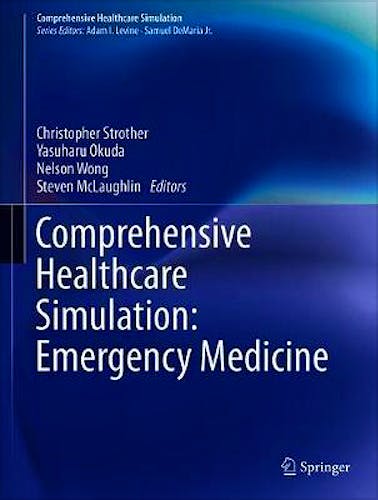

No hay productos en el carrito



Comprehensive Healthcare Simulation: Emergency Medicine
Strother, C. — Okuda, Y. — Wong, N. — McLaughlin, S.
1ª Edición Marzo 2021
Inglés
Tapa blanda
312 pags
800 gr
21 x 28 x 2 cm
ISBN 9783030573652
Editorial SPRINGER
LIBRO IMPRESO
-5%
124,79 €118,55 €IVA incluido
119,99 €113,99 €IVA no incluido
Recíbelo en un plazo de
2 - 3 semanas
LIBRO ELECTRÓNICO
-5%
103,99 €98,79 €IVA incluido
99,99 €94,99 €IVA no incluido
Acceso On Line
Inmediato
PART I. INTRODUCTION TO SIMULATION FOR EMERGENCY MEDICINE.- 1.A Historical Perspective of Simulation in Emergency Medicine.-2. Education and Learning Theory.- 3. Simulation Scenario Development and Design in Emergency Medicine.- 4. Debriefing in Emergency Medicine.- 5. Crisis Resource Management.- 6. Interdisciplinary Teamwork Training.- 7. Simulation-based Measurement and Program Evaluation: Demonstrating Effectiveness.-8. Patient Safety.- PART II. SIMULATION MODALITIES AND TECHNOLOGIES.- 9. Standardized Participants.- 10. Virtual Environment for Education in Healthcare.- 11. Task Trainers in Emergency Care Simulation.- 12. Mannequin Simulators.- 13. Emergency Medicine Simulation Moulage.- PART III. THE PRACTICE OF EMERGENCY MEDICINE.- 14. Simulation for ED Medical Directors and Administrators.- 15. Simulation in Undergraduate Medical Education.- 16. Simulation in Graduate Medical Education.- 17. Emergency Nursing Continuing Professional Development Using Simulation.- 18. Simulation in Emergency Medical Services.- PART IV. SUBSPECIALTIES OF EMERGENCY MEDICINE.- 19. Pediatric Emergency Medicine.- 20. Trauma.- 21. EM Critical Care.- 22. Ultrasound.- 23. Disaster Medicine.- 24. Simulation in Defense and Combat Medicine.- PART V. CONCLUSION.- 25. The History, Present and Future of Healthcare Simulation.
This is a practical guide to the use of simulation in emergency medicine training and evaluation. It covers scenario building, debriefing, and feedback, and it discusses the use of simulation for different purposes, including education, crisis resource management and interdisciplinary team training. Divided into five sections, the book begins with the historical foundations of emergency medicine, as well as education and learning theory. In order to effectively relay different simulation modalities and technologies, subsequent chapters feature an extensive number of practical scenarios to allow readers to build a curriculum. These simulations include pediatric emergency medicine, trauma, disaster medicine, and ultrasound. Chapters are also organized to meet the needs of readers who are in different stages of their education, ranging from undergraduate students to medical directors. The book then concludes with a discussion on the future and projected developments of simulation training. Comprehensive Healthcare Simulation: Emergency Medicine is an invaluable resource for a variety of learners, from medical students, residents, and practicing emergency physicians to emergency medical technicians, and health-related professionals.
Christopher Strother, MD Department of Emergency Medicine Simulation Teaching and Research Center Mount Sinai Hospital Icahn School of Medicine New York, NY, USA
Yasuharu Okuda, MDDivision of Emergency Medicine Center for Advanced Medical Learning and SimulationUniversity of South Florida Health Morsani College of Medicine Tampa, Florida, USA
Nelson Wong, MD, MSHPEd Veterans Health Affairs Sim LEARN Veterans Affairs Palo Alto Health Care Center Department of Emergency Medicine Stanford University School of Medicine
Steven McLaughlin, MD Department of Emergency Medicine University of New Mexico School of Medicine Albuquerque, NM, USA
© 2026 Axón Librería S.L.
2.149.0